IV. PROSTRATION AND COLLAPSE
1. The splintering of Hellenism 153
2. The Latin administration 159
3. Interplay of the Greek and Latin cultures 162
4. Reconquest of Constantinople 164
1. THE SPLINTERING OF HELLENISM
The consequences of the Crusaders’ act in the final Islamic victory over the Greek empire were great, but the immediate effects were also significant. Loss of The City (ἡ πόλις), as Greeks called Constantinople then and as they call it even today, splintered the unity of medieval Greek society. The Greeks could no longer consider Constantinople, over whose political and religious life a western emperor and a Catholic patriarch presided, as the focal point of their loyalty, though desire for and belief in the ultimate repossession of the city constituted a dominating motive in the Orthodox world. Constantinople was lost, but the empire survived. While the Latins occupied the queen of cities and many of the provinces, Greek nobles, clergy, and soldiers fled in large numbers to those districts which were still free from the Westerners. In these areas, to which mountains or seas barred the Latins from ready access, Greek political entities crystallized around the cities of Nicaea, Trebizond and Arta (in Epirus). The newly-formed kingdoms competed with one another for the allegiance of the Greeks, and their competition to reconquer Constantinople from the Latins somewhat eased the pressure on the latter. The founders of the dynasties which took root in Epirus, Bithynia and Chaldia were all related to imperial families and their dynastic connections greatly enhanced their claims to the obedience of the provincial Greeks. The political splintering of the Byzantine world which resulted from the Latin conquest not only retarded the Greek reconquest of Constantinople but, as it survived long after 1261, further contributed to the final collapse. However, the existence of independent states in Pontus, western Asia Minor and western Greece served to revitalize the Hellenism of those areas, for the rulers did much to foster the economic, religious and cultural life of their subjects.
153
![]()
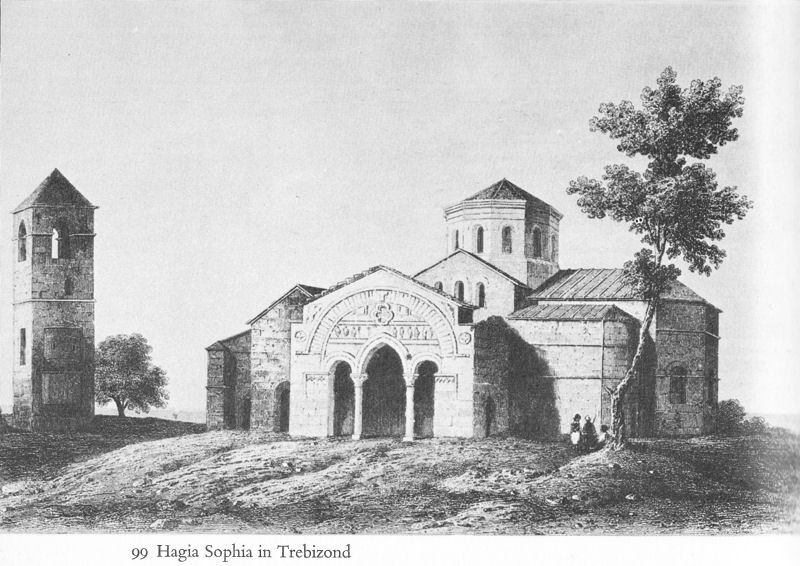
99 Hagia Sophia in Trebizond
Michael Angelus Comnenus Ducas, founder of the despotate of Epirus, had decided to make his political fortune by joining the Latin conquerors of Greece. But it soon became evident to the Byzantine adventurer that there was very little hope of fulfilling his ambitions as a soldier in the Latin armies, so he turned elsewhere. Relying upon family connections in central and western Greece, Michael Angelus succeeded in taking Arta where he forced the deposed but itinerant Alexius III to crown him despot, thereby dignifying his opportunism with legitimacy. A wily politician and vigorous campaigner who knew how to manipulate Latins and Bulgars, he soon expanded the boundaries of the despotate westward to Dyrrachium and eastward to Thessaly.
Trebizond enjoyed even greater protection from Latin aggrandizement than did Epirus, for it was several hundred miles distant from the Latins, and the city could boast of many other advantages.
154
![]()
Its strategic geographical location made of it one of the great commercial emporia of the east, where Latin and Greek boats met Muslim caravans, bringing profitable income to the Trebizondines. Though the immediate hinterland of the city was not extensive (the Turks ruled the plateau to the south of the mountains) it was well watered and fertile. The Turkish conquest of the plateau had largely isolated Trebizond in the late eleventh century and stimulated separatist sentiment among many of its inhabitants. The most powerful family in the region, that of Gabras, had caused the Comnenoi many anxious moments as they demonstrated their independence quite openly; indeed, the history of this aristocratic clan in the twelfth century is particularly interesting. One Gabras, principal defender of Trebizond against the Turks, was put to death by them for refusing to apostatize, and a special service was sung in his honour as late as the nineteenth century. Paradoxically, another branch of the family furnished three viziers to the Seljuk court at Konya.
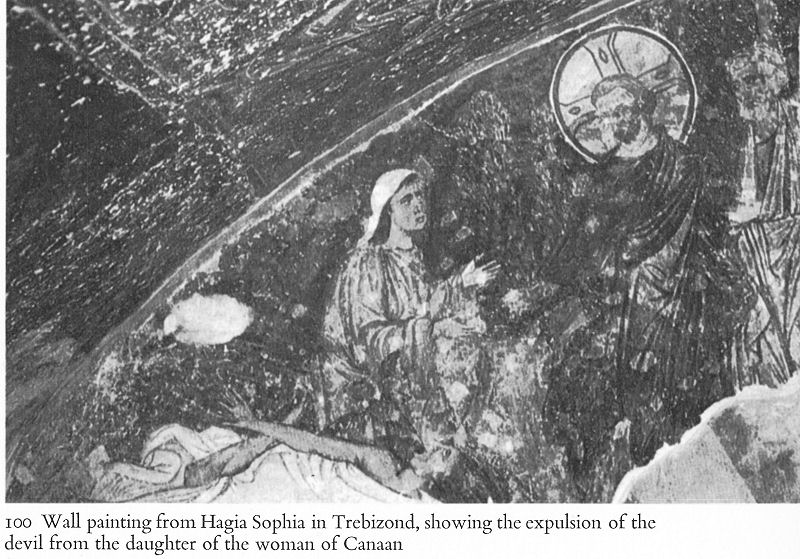
100 Wall painting from Hagia Sophia in Trebizond, showing die expulsion of die devil from the daughter of the woman of Canaan
155
![]()

101 The walls of Nicaea
The individuality of the city is further reflected in the pride of its panegyrists who always pointed to its colonization in antiquity by Athenians (via Sinope and Miletus). As in the case of the founder of the Epirote despotate, Alexius and David Comnenus were not only related to an emperor, but their family had strong local connections. Their grandfather, Andronicus I, had governed Sinope, and their aunt was Queen Thamar of Georgia. The two princes had escaped the massacre of Andronicus’ family, which accompanied his fall in 1185, and had been raised at the Georgian court. Thamar took advantage of the Latin pressure on Constantinople in 1204 to occupy the city of Trebizond with Georgian troops and then to place her nephews in control of it. David, the more daring of the brothers, soon expanded control over the Pontus Littoral from Trebizond to Heracleia in the west.
It was the third of these Greek succession states, the empire of Nicaea, which was fated to restore Byzantine honour in Constantinople. Unlike Trebizond (which was too far away) and Epirus (which was economically poor), Nicaea enjoyed both a propitious geographical location and the possession of an extensive, fertile 156 hinterland.
156
![]()
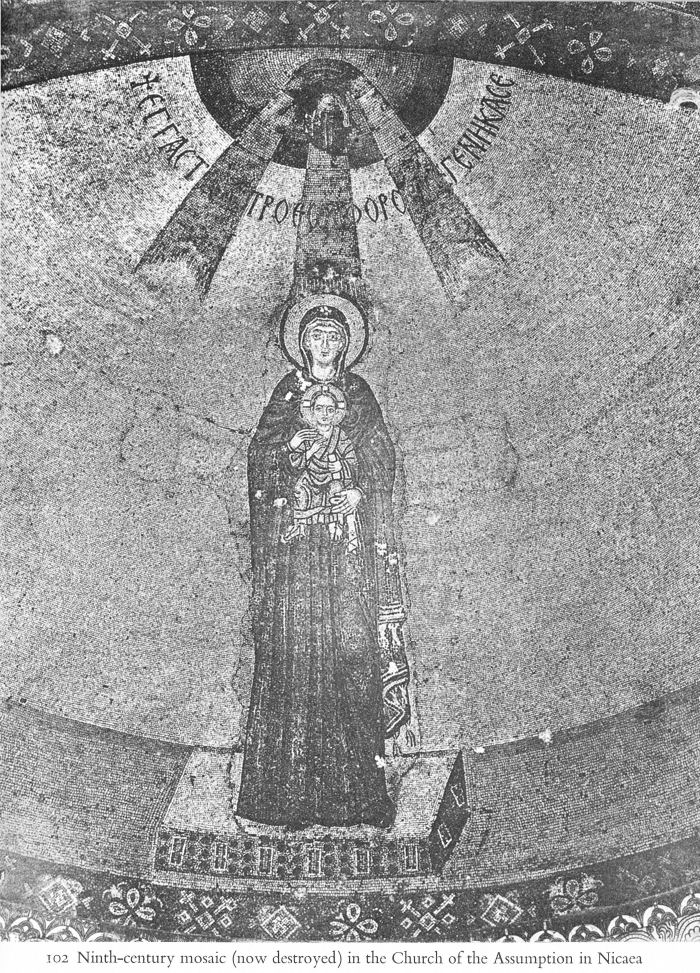
102 Ninth-century mosaic (now destroyed) in the Church of the Assumption in Nicaea
157
![]()
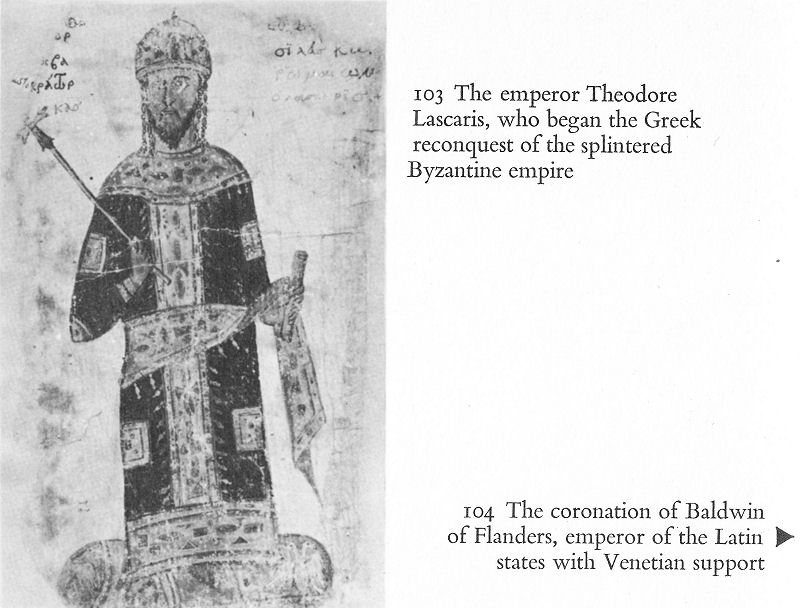
103 The emperor Theodore Lascaris, who began the Greek reconquest of the splintered Byzantine empire
The rich valleys of western Anatolia, watered by the rivers that streamed down from the mountains, supported a prosperous agricultural life and a dense population, while the important cities of Smyrna, Ephesus, Magnesia, Pergamum, Prusa, Nicomedia and Nicaea gave this region a strong commercial and urban character. The city of Nicaea, closer to Constantinople than Trebizond or Arta, was nevertheless virtually impregnable, located as it was on the shores of Lake Ascania and surrounded by strong walls. In addition it enjoyed the prestige of having been the scene of the first and last of the ecumenical councils recognized by the Greek Church.
The despot Theodore Lascaris was one of those Byzantine officials who had left the capital, preferring to fight on in western Anatolia. The situation in these regions was extremely confused as other Greeks began to establish rival principalities and, more important, Latins, Seljuks and Trebizondines began to press in on all sides. But Theodore obtained a respite to organize his forces after the Latin empire suffered a disastrous defeat at the hands of the Bulgarian monarch Ioannitsa in 1205. Three years later, the Church having elected a new patriarch, Theodore was crowned emperor and so the imperial traditions took root in the Byzantine polity of Nicaea.
158
![]()
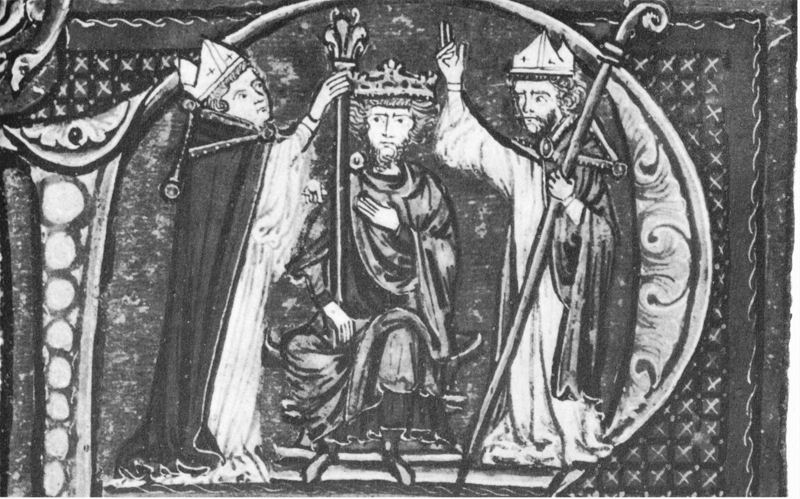
104 The coronation of Baldwin of Flanders, emperor of the Latin states with Venetian support
Kaihusrau, Sultan of Konya and host of Alexius III, decided to invade the Nicaean domains in 1211, on the pretext of restoring Alexius but actually to conquer the land. In a hotly contested battle which took place near the Maeander River, Theodore killed the Sultan and the victory which followed assured the eastern boundaries of the state. By 1214 peace had been concluded with the Latins and Theodore had reconquered from the Comnenoi the Black Sea coast as far east as Sinope.
2. THE LATIN ADMINISTRATION
The Latin settlement of those lands which had been successfully wrested from the Greeks was a complex one. The Doge Dandolo, who had feared the ambitions of Boniface, saw to it that a weaker man, Baldwin of Flanders, was elected emperor, while the Venetian Thomas Morosini was chosen patriarch. The partition of the conquest proceeded according to the general lines previously agreed upon. Baldwin received Thrace, five-eighths of Constantinople, northwest Asia Minor, and a few of the islands.
159
![]()
His frustrated competitor Boniface took the important city of Thessalonica with adjacent lands in Macedonia and Thessaly, giving Attica and Boeotia to his vassal, Otto de la Roche. The Venetians, political realists that they were, claimed only those regions which would constitute no liability for their commercial interests, the most important being the section of Constantinople (three-eighths) which they received. In addition they acquired Dyrrachium, Ragusa (on the Dalmatian coast), Coron, Modon (in the southern Peloponnese), certain ports on the Hellespont and Marmora, and the city of Adrianople. In terms of actual territory the Ionian islands, Crete, and the isles of the Aegean constituted the bulk of their holdings.
The Peloponnese, or Morea as it was called, capitulated to William of Champlitte and Geoffrey of Villhardouin. Spectacular as the victory of the Latins had been, the congeries of Latin states which arose represented a dismally weak political system which could exist only because of the threefold division of the Greeks. The Crusaders superimposed a developed western feudal system over their new lands which produced a fatal decentralization of power. Though all the knights held their lands from the emperor of Constantinople, the interests of the Latins in the provinces often diverged from his. And the Venetians had been careful to stipulate that they were not required to swear the oath of fealty to the emperor, a factor which further weakened the Latin empire.
The basic weakness of the new Latin states lay in the fact that the subject population was largely Greek and so loyalty to the ruling class was largely, though not universally, absent. Ecclesiastical differences cemented the hatred of the Greeks for their new masters, for one of the basic policies of the Latins was to establish the ecclesiastical supremacy of the Catholic Church. Pope Innocent III, excited by the prospect of bringing the Greek Church into the Catholic fold, was outraged by the massacre and rapine which accompanied the Latin entry into Constantinople, and repeatedly admonished Latin clerics and lords to treat the Greeks in a more Christian manner, but usually to no avail.
A number of the Greek bishops, including the patriarch of Constantinople and the famous archbishop of Athens, Michael Acominatus, had fled the Latin-held lands, seeking refuge in Epirus, Nicaea, Bulgaria and Trebizond.
160
![]()
Others remained in their sees, sometimes ignoring Latin ecclesiastical demands and often maintaining contact with the clergy in non-Latin territory. The Catholics decided that the Greek clergy were to keep the churches in those regions inhabited exclusively by Greeks, but in mixed areas the bishops were to be Latins. The hierarchy of the Church in the conquered areas thus passed into the hands of the Catholics, whereas the village priests remained Greek. With some exceptions the Latin bishoprics were filled by adventurers little inspired by the religious life, who treated their Greek parishioners as schismatics. Very often the Greek clergy who conformed to the demands of the papacy and hence were supported by Innocent, were removed by fanatic Latin bishops who wished to take over all the bishoprics.
The Greek bishops were often equally irreconcilable. The archbishop of Corfu, for example, roundly told the Crusaders who stopped there en route for Constantinople in 1203 that he could not understand their arguments in favour of papal primacy unless they were referring to the fact that it was Roman soldiers who had crucified Christ. Nevertheless, in spite of their great political animosity, the Nicaean Greeks and the Latins did engage in religious discussions, the most important of which were held in Constantinople (1206,1214-15). The appearance of Nicholas Mesarites, metropolitan of Ephesus, as the Greek representative undoubtedly helped to strengthen the resistance of the Greeks in Constantinople, but it did little to improve relations between the two Churches. The hostility and rigidity of Catholic and Orthodox extended even to details of protocol and procedure. The dispute between the papal cardinal and Mesarites over precedence is a case in point. When Mesarites entered Hagia Sophia the cardinal failed to rise in greeting, alleging that as he wore purple slippers, to rise would be unbecoming to the imperial dignity which attached to the wearing of purple. The metropolitan of Ephesus was not to be outdone, however, and pulling off his slipper, displayed that its lining was purple also.
Being more humble than his Latin adversary, he claimed, he had naturally refrained from a more ostentatious display of the purple!
161
![]()
3. INTERPLAY OF THE GREEK AND LATIN CULTURES
The intercourse of Greeks and Latins was perhaps less agitated in spheres other than the religious. The fusion of Byzantine and Frankish elements in the Peloponnese is reflected in the so-called Chronicle of the Morea, the text of which exists in Greek, French, Aragonese, and Italian. The Greek magnates of the peninsula joined with the Latin knights and formed one feudal society. The Byzantine pronoia was equated with the Frankish fief, and the two terms were used interchangeably in the Chronicle. Latin feudalism was thus grafted on to the Byzantine land-holding system and such Latin terms as liege (already known in the relations between Comnenoi and the Crusading lords) and homage passed into Greek by transliteration (lizios) and translation (anthropea).
The same sort of accommodation seems to have occurred in the field of literature. Greek and French romance literature followed a similar evolution, and just as parallel developments in Byzantine and Latin feudalism had prepared the way for a fusion of the two, so a fusion took place in the case of this type of literature. There was also a direct influence of the French romance on that of the Byzantines as the latter developed in the thirteenth and subsequent centuries.
The preponderance of the west in economic life, so evident in the twelfth century, was now firmly established. The influence of the Italian merchants became so great that the maritime and mercantile vocabularies, not only of Greek, but later of Turkish as well, were largely Italian. The results of this Latin dominance were strongest in those Venetian insular possessions which remained under western rule until the late eighteenth century. Though proselytization by the Catholic Church failed to attain the same degree of success in the Ionian islands as in certain of the islands of the Aegean, the cultural borrowing of the Ionian islanders was very extensive. The most felicitous blending of the two strains is to be seen in the great school of Cretan painting, which continued in the Ionian islands after the Turkish conquest of Crete in the seventeenth century caused the painters to disperse. The literature of the islanders also experienced a new flowering under the inspiration of Italian models.
162
![]()
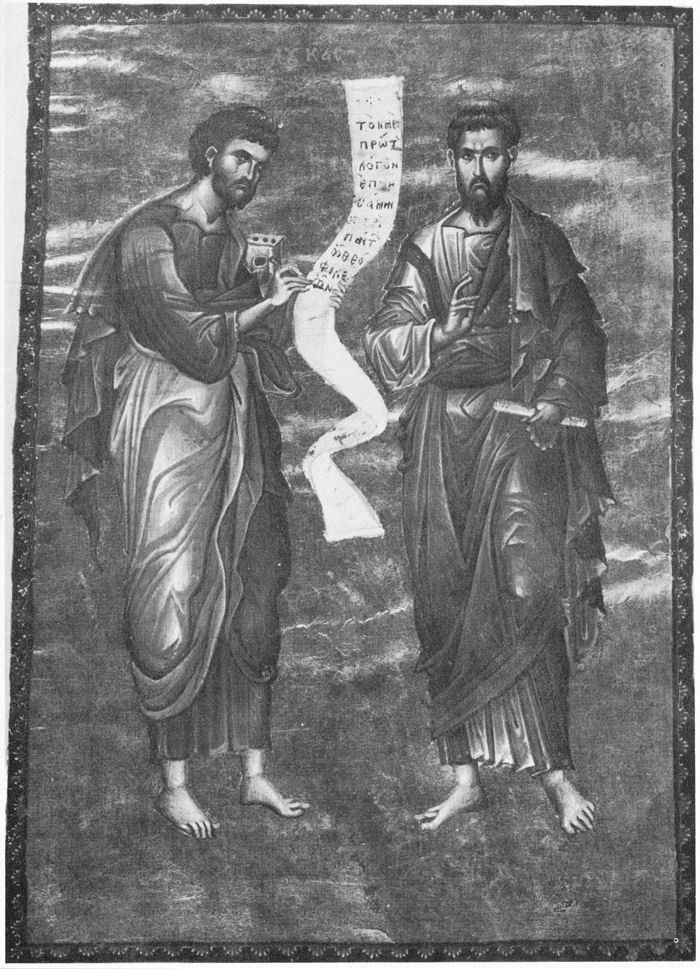
105 St Luke and St James, painted in Constantinople, probably in the thirteenth century; from an Acts and Epistles
163
![]()
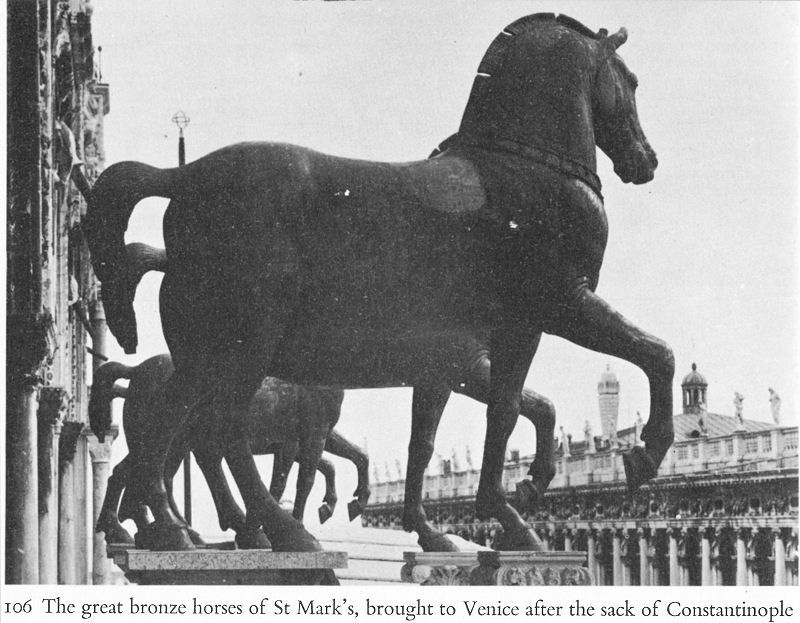
106 The great bronze horses of St Mark’s, brought to Venice after the sack of Constantinople
The Italian imprint on the Ionian islands was so strong that their inhabitants had a different outlook from that of their compatriots on the mainland even as late as the nineteenth century.
The most obvious type of Latin ‘borrowing’ from the Greeks consisted of the objects of classical and Byzantine art which came into Europe after 1204, the most famous of which are the great bronze horses standing over the entrance to St Mark’s in Venice. Constantinople, the great repository of holy relics, now became the supply house for all Europe. More exceptional was the case of William of Moerbeke, archbishop of Corinth (1277-81), who translated many of Aristotle’s works into Latin. But as interest in the reunion of the two Churches spread in the west, the desire to learn Greek was motivated more by religious than by other considerations.
4. RECONQUEST OF CONSTANTINOPLE
In the competition between the Balkan and Asiatic Greeks to reconquer Constantinople fortune at first favoured the despotate of 164 Epirus.
164
![]()
Theodore Angelus, successor of Michael Angelus, took Thessalonica from the Latins in 1224 and had himself crowned emperor soon afterwards by the archbishop of Ochrid. His defeat at the hands of the Bulgarian Tsar Asen II on the field of Klokotinitza in 1230 put an abrupt end to Epirote imperial pretensions. Until his death in 1241 Asen enjoyed a certain pre-eminence in Balkan affairs, but it was the Nicaeans who finally began to extend their control in Thrace and Macedonia.
Under the leadership of John III Ducas Vatatzes (1222-54) the empire of Nicaea emerged as the most powerful of the Greek states, playing a rôle which was something more than local. Vatatzes concluded a marriage alliance with Frederick II, talked with the pope of union, and concluded an agreement with the Seljuks in the face of the Mongol storm. Internally he succeeded in restoring great prosperity to his Anatolian realm. A tariff policy which protected local manufactures against Italian competition revived the old Byzantine textile industry, while the warehouses of the ports were full of goods from all over the world. He paid particular attention to the towns, fdling their silos with agricultural products and maintaining at state expense craftsmen who specialized in the making of arms. Education also profited as he brought together collections of books in the various cities. His reign demonstrates the advantageous side of that splintering which the Latin conquest of 1204 had caused, for prior to that date the Byzantine capital had neglected its fairest province. Furthermore, his extension of Nicaean power in the Balkans, crowned by the occupation of Thessalonica in 1246, isolated the Latins in Constantinople, and made the final reconquest only a matter of time.
The final triumph was, ironically, not to be the work of the Lascarid dynasty, for in 1258 Michael Palaeologus, descendent of an old aristocratic family, seized effective control of power and founded the most long-lived of the Byzantine imperial dynasties. At this juncture the rapid progress of the Anatolian Greeks had inspired their enemies to come together in a last effort to thwart their further advance. Manfred, the son of Frederick II, put himself at the head of a coalition which also included the despotate of Epirus and the Latin principality of the Morea.
165
![]()
The fateful battle at Pelagonia in western Greece (1259) was a smashing victory for Michael Palaeologus, which left him free not only to concentrate on Constantinople, but also to advance in the Morea. In order to neutralize the Venetian navy, the only force still capable of effective resistance, Michael secured Genoese support by the treaty of Nymphaeum, which guaranteed Genoese merchants very handsome commercial rewards within the empire. But Genoese aid proved unnecessary, for a small body of Nicaean troops, reconnoitring in the neighbourhood of Constantinople, found the city undefended and took it with ease on 25 June 1261. In the joyous celebration which followed, Michael had himself crowned anew by the patriarch, this time in Hagia Sophia. In this way the traditions of Constantinople as head of the Greek empire and Church were renewed.
The expulsion of the hated Franks from Constantinople was a great victory for Byzantium, but in other ways it was a source of ill fortune. Once in possession of Constantinople, Michael found himself involved not only with the various Balkan states, but above all with Latin Crusaders who hoped to re-establish the Latin empire of Constantinople. Furthermore, in shifting the capital to Europe, Michael turned his back on western Anatolia and neglected the very provinces which had made the reconquest possible. The neglect of these regions at the very moment when Turkish pressure was once more increasing was to prove fatal. The more immediate danger, however, came from developments in the west where the ambitious Charles of Anjou, brother of the French King Louis IX, had won the kingdom of Sicily from Manfred. By the treaty of Viterbo (1267) with Baldwin II, the deposed emperor of Constantinople, Charles began to muster allies for an expedition against Constantinople. His diplomacy built up connections with the Latin Morea, Epirus, the Bulgars and the Serbs, and for fifteen years Michael VIII lived under the threat of a Latin Crusade. Fortunately Byzantine diplomatic skill prevented Charles from launching his Crusade. As a first step Michael concluded an ecclesiastical union with the Latin Church at Lyons in 1274, accepting papal supremacy in return for which the pope compelled Charles to desist from his plans. The succession of the French pope Martin IV gave Charles another opportunity, and
166
![]()
he was on the point of unleashing his forces when the outbreak of the Sicilian Vespers (1282) put an end to his schemes. Byzantine gold was used to encourage discontent in Sicily and brought the forces of Peter III of Aragon into the island.
5. A TEMPORARY VICTORY
Michael VIII had succeeded in raising Byzantium once more to a position of world prominence by virtue of his spectacular victories over the Latins. But the accomplishment was ephemeral, and the possession of Constantinople proved to be a burden beyond the means of a government which had abandoned its real base of strength in Asia Minor in order to pursue a deceptive policy of glory in the Balkans. Though the consequences of Michael’s policy were not fully revealed during his lifetime, the fact remained that, having plunged into the political world of the Balkans and the west, the Byzantine state could not turn back, although it was physically unequal to the task. Furthermore, Michael’s dynastic, military and economic policies reduced Byzantine Anatolia to a rebellious province in which the native soldiery was disbanded, agricultural life dislocated, and the ecclesiastical hierarchy alienated.
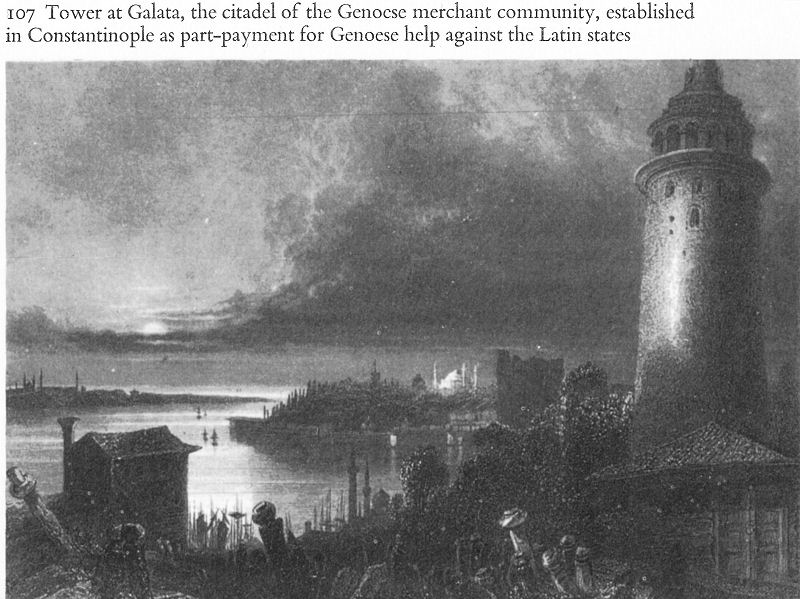
107 Tower at Galata, the citadel of the Genoese merchant community, established in Constantinople as part-payment for Genoese help against the Latin states
167
![]()
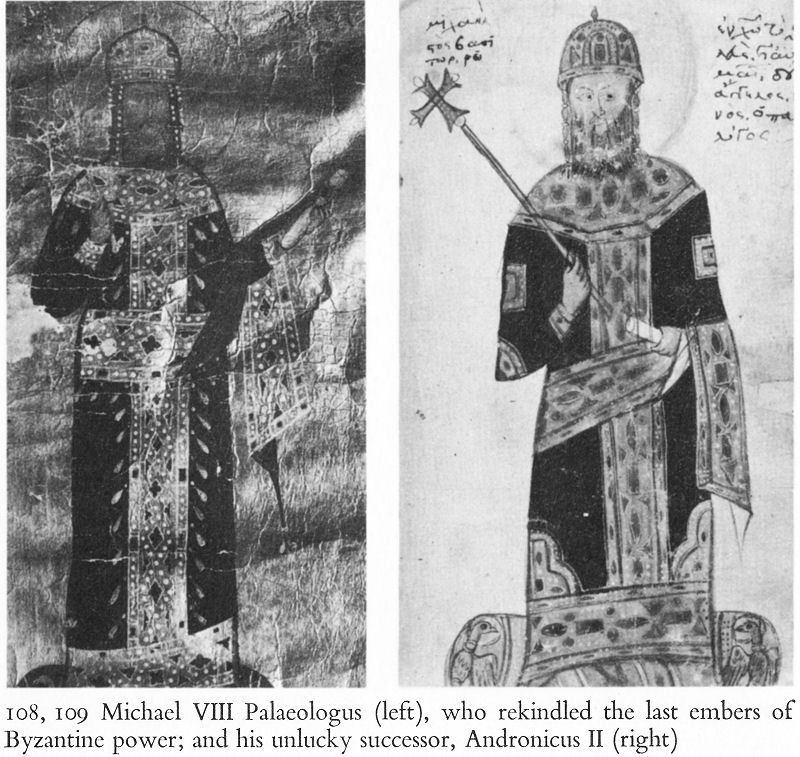
108, 109 Michael VIII Palaeologus (left), who rekindled the last embers of Byzantine power; and his unlucky successor, Andronicus II (right)
Andronicus II (1282-1328) harvested the bitter fruit of Michael’s labours, for though he succeeded to the throne in Constantinople rather than in Nicaea he found the state exhausted by Michael’s policies. The story of the empire after the death of Michael VIII becomes a tale of military disaster, economic decline, and political catastrophe which makes melancholy reading. The pretensions of Michael had subjected the empire to increasing demands at a time when its resources were diminishing. When he usurped the imperial power Michael had sought to satisfy his military and aristocratic supporters by making their pronoia or fiefs hereditary. This set a precedent, and during the next two centuries there was a steady increase in the number of hereditary pronoia, often accompanied by freedom from military service. At the same time the Palaeologoi granted an increasing number of tax exemptions to the possessors of non-military lands, with the result that tax revenues and military personnel steadily decreased.
168
![]()
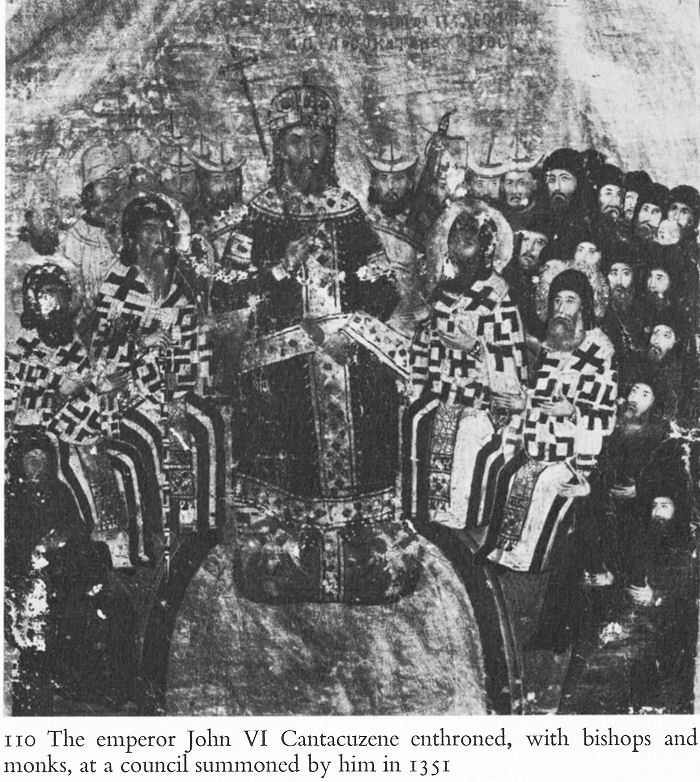
110 The emperor John VI Cantacuzene enthroned, with bishops and monks, at a council summoned by him in 1351
Customs revenue also shrank, as a consequence of the stranglehold of the Genoese and Venetians over the economic life of the empire. While by the fourteenth century the annual customs revenues of the Genoese in Galata reached the sum of 200,000 hyperpera, across the Golden Horn in Constantinople the Greeks levied only 30,000 hyperpera. It is estimated that at the end of the thirteenth century the income of the state was only one-eighth of what it had been under the Isaurian dynasty. This impoverishment even affected the sumptuous court ceremonial; at the coronation of John VI Cantacuzene, for example, the gold and silver plate was replaced by plate of lead and clay.
Dynastic competition, social struggles and religious strife during the fourteenth century destroyed what little strength the empire possessed and played into the hands of the Serbs and Ottoman Turks.
169
![]()
In 1321 Andronicus III, grandson of Andronicus II, raised the spectre of dynastic rebellion by marching on the capital and forcing his grandfather to give him part of Macedonia and Thrace. When the family strife was renewed the two emperors sought support from the Serbs and the Bulgars. The sins of Andronicus III were visited upon his own younger son John V, for upon the latter’s accession John Cantacuzene had himself declared emperor. During the next fourteen years the empire suffered the horrors of intense civil war, and once again the rival parties, placing their own political interests above the welfare of the state, competed for the services of Serbs, Turks, and Venetians.
The religious controversy over Hesychasm further paralysed society in the mid-fourteenth century as the exponents of Hesychast doctrine sided with Cantacuzene and the opponents with John V. The controversy arose when the westerner Barlaam attacked the mystical exercises of the monks of Mount Athos and Gregory Palamas came to their defence. The hesychast attained mystical ecstasy by sitting on his legs, head on chest and eyes focused on the navel, invoking the name of Jesus as he held his breath. By this exercise the mystic saw the uncreated light which surrounded Jesus at the Transfiguration on Mount Tabor. The conflict was not only theological, it also represented another phase in the continuing encounter between Byzantine monasticism and humanistic traditions. Hesychasm was vindicated because of the support it received from Cantacuzene, but eventually it was restricted to a small number of ascetics.
Nevertheless, this last great theological debate of the Eastern Church was important in so far as it contributed to the anarchy and confusion of Byzantine society which the civil wars had caused. In the course of the struggle the regency of John V also fomented class strife at the expense of Cantacuzene, who represented the aristocracy of Byzantine society. Because of the civil war and political and economic decline, the gap separating the rich from the poor had greatly widened and at the prodding of the government of John V the lower classes (the political zealots) rose in the towns of Thrace and Macedonia, establishing their own municipal government in Thessalonica and expelling the aristocrats.
170
![]()
When John Cantacuzene finally fell from power in 1354 and retired to a monastery to write his famous history, he left the empire in a shambles. Society had been split along dynastic, social and religious lines, while Serbs and Turks had not only been allowed to expand at the expense of Byzantium but had been brought in as mercenaries. The years of civil war had seriously dislocated Byzantine society, disrupting agriculture and destroying the tax-producing elements in the provinces.
Exploiting this weakness the Serbian ruler Milutin (1282-1321) had by the end of the thirteenth century pushed ahead with the conquest of Macedonia south of Skoplje. The civil wars of the fourteenth century brought the Serbs as far south as Thessaly and Aetolia after they had eliminated their Bulgarian neighbours at the battle of Velbuzd (1330). The Serbian involvement in Byzantine affairs, which began during the civil war of Andronicus II and Andronicus III, reached a high point during the reign of the great Serbian ruler Stephan Dušan (1331-55). Dušan first concluded an alliance with Cantacuzene in 1342-43, but soon abandoned him for John V in order to further his own interests. As Cantacuzene turned towards Constantinople and abandoned Macedonia, Dušan occupied most of Albania, and of central and northern Greece, and in 1346 the Serbian patriarch crowned him emperor of the Serbs and Greeks.
Like the Bulgarian ruler Symeon during the tenth century, Dušan attempted to found an empire on the Byzantine pattern, but his effort was short-lived for on his death (1355) the Serbian empire collapsed and was replaced by a number of petty states.
6. THE RISE OF THE TURKS
The real danger, however, lay not in the Balkans but in Asia Minor. Here were the bellicose Turks who, having inherited the doctrine of holy war from the faltering Arabs, were to carry the centuries-old conflict between Byzantine Christendom and Islam to a conclusion. Turkish conquest and rule, by now three hundred years old in much of Anatolia, had effected great changes in the peninsula. Prior to the battle of Manzikert the population of Asia Minor had consisted largely of Greeks and Armenians, and even as late as the mid-thirteenth century they outnumbered their Turkish neighbours.
171
![]()
But with the establishment of the Muslim Turks in the peninsula the Christians of Asia Minor were subject to relentless cultural pressures, for, as the Arab historian Ibn Khaldun observed, ‘A nation that has been defeated and comes under the rule of another nation will quickly perish.’
The Turkish conquests and settlements in Anatolia had caused considerable upheaval, dislocation and destruction among the Christians, and the peninsula was not to be pacified until the latter half of the fifteenth century. The Church in particular was crushed as it lost its properties, churches and income, and was subjected to heavy taxation in the period prior to the unification of Anatolia by Muhammed II. The Orthodox Christians, cut off from the heart of their society and deprived of effective Christian leadership (for the bishops were excluded from their sees in Turkish lands for long periods), were exposed to strong proselytizing currents in the new Islamic society. Because of the upheavals which Christian society had experienced, the Dervish orders, most prominent of which were the Mevlevis and Bektashis, found the Christians psychologically prepared for their religious preaching.
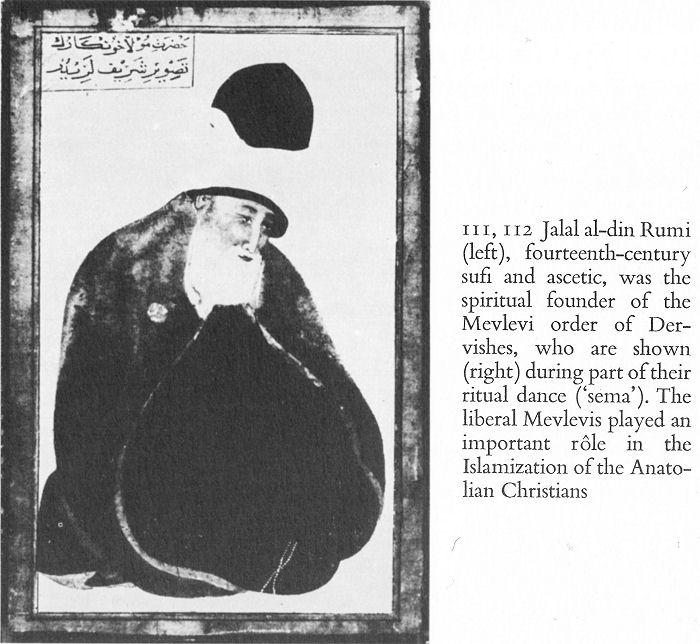
111, 112 Jalal al-din Rumi (left), fourteenth-century sufi and ascetic, was the spiritual founder of the Mevlevi order of Dervishes, who are shown (right) during part of their ritual dance (‘semaj. The liberal Mevlevis played an important rôle in the Islamization of the Anatolian Christians
172
![]()
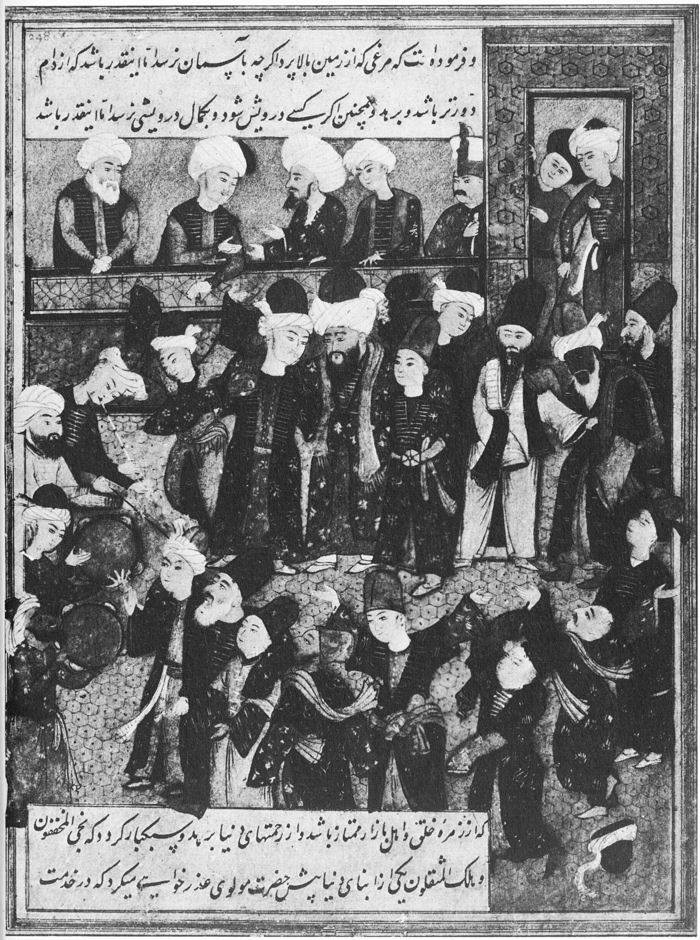
173
![]()
These sufi brotherhoods were thus instrumental in transforming the majority of the Greek and Armenian Christians into Turkish Muslims, and in so doing they effected a cultural revolution equivalent in magnitude to that which the Arabs had carried through centuries earlier in Byzantine Syria, Egypt and Palestine.
The political life of Anatolia had been temporarily stabilized with the establishment of the empire of Nicaea and the emergence of a strong sultanate of Konya in the first half of the thirteenth century. But the withdrawal of Michael VIII to Constantinople in 1261 once more relegated western Anatolia to administrative chaos and economic decline. Meanwhile, on the Islamic side, Seljuk prosperity was destroyed when the rebellions of the Turkmen tribes so weakened the sultanate that it fell a victim to the Mongols in 1243. The disappearance of these two stabilizing forces once more turned Anatolia into a battlefield of Turkish chieftains who, at the head of various combinations of tribes, carved out a number of petty Turkish principalities as they overran the Seljuk and Byzantine domains. The most important of these emirates, that of Osman, was located in northwest Anatolia on the borders of Byzantine Bithynia. By the early fourteenth century, Osman was able to exploit the decline of Byzantine control to conquer most of this region, and his son Orhan rounded out the conquest by reducing Prusa (1326), Nicaea (1331), and Nicomedia (1337).
After a few decades of consolidation, in which the Christian and Muslim elements and institutions of Bithynia fused to produce early Ottoman society, the Ottoman Turks crossed the Dardenelles to Europe much as the Nicaean Greeks had done during the thirteenth century. Cantacuzene had secured the help of Turkish troops in the civil war by giving his daughter in marriage to the Sultan Orhan in 1344-45, and introduced them into Thrace where they plundered the populace mercilessly. Ten years later, after a fearful earthquake had destroyed the walls of Gallipolis, Orhan seized this key town on the European side of the straits and the Turkish conquest of the Balkans began. The collapse of Dušan’s empire, together with the weakness of Bulgaria and Byzantium, created a power vacuum which literally sucked the Turks into Europe.
174
![]()
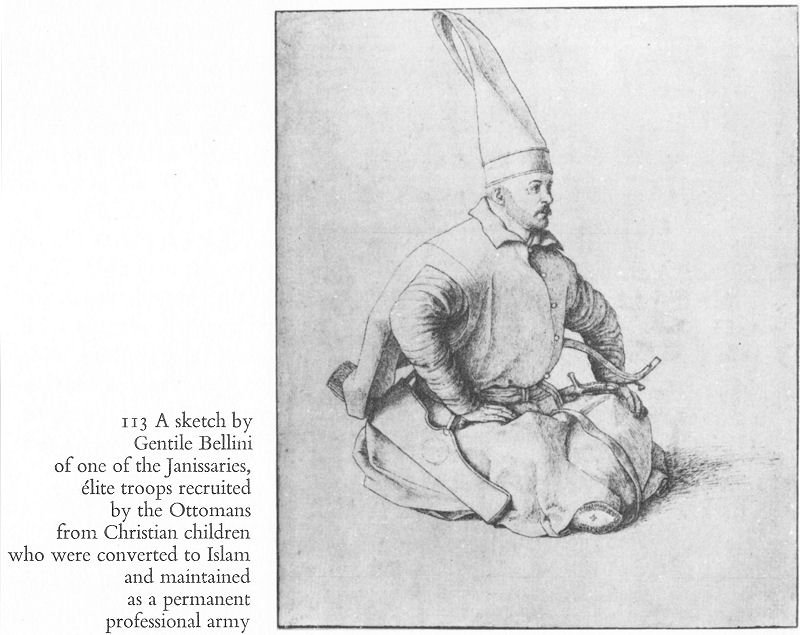
113 A sketch by Gentile Bellini of one of the Janissaries, elite troops recruited by the Ottomans from Christian children who were converted to Islam and maintained as a permanent professional army
By 1365 they had shifted their capital from Prusa to the European city of Adrianople, symbolizing in this manner the westward orientation of their political programme. Though the Turks bypassed the city of Constantinople because of its defensive strength their advance subdued the Bulgars and then brought the Serbs to their knees at the battle of Kossovo in 1389. The Sultans had succeeded because of the weakness of their opponents but also because they had created the most formidable military machine in all of Europe and the Near East. Much of the vitality of both the military and the administration derived from the system by which the Ottomans took the cream of the Christian youth, converted them to Islam, and then trained them to wield the sword and the pen. The crack troops, the Janissaries, and eventually the viziers were recruited from these converted Christian youths, the devshirmes.
175
![]()
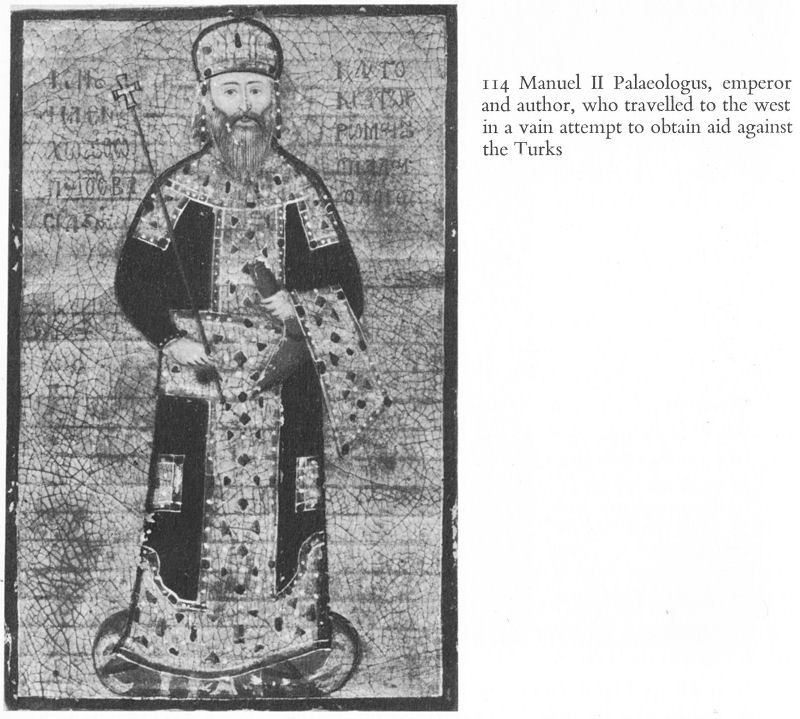
114 Manuel II Palaeologus, emperor and author, who travelled to the west in a vain attempt to obtain aid against the Turks
When Bayezid I Yildirim, the Thunderbolt, succeeded his father Murad I and expanded deep into both the Balkans and Anatolia, the days of the empire grew shorter. Bayezid’s conquests in Europe were put to a severe test by the appearance of a crusading force under Sigismund of Hungary. Though the initial impact of the western knights at the battle of Nicopolis (1396) alarmed the Ottoman ranks, the forces of the Sultan annihilated the Crusaders. This victory proved that the Sultan’s position in the Balkans was firmly established, and Manuel II Palaeologus, fearing that the end was in sight, left his capital in 1399 and went to Venice, London, and Paris to seek aid. Only a miracle could now save Constantinople, immersed as it was in an Ottoman sea. Once more in its long history, however, a miracle did occur and the life of Greek Constantinople was prolonged another half century.
176
![]()
For in 1402 Bayezid met his master at the battle of Angora where the last great world conqueror in the steppe tradition, Timur (Tamerlane), crushed the Ottomans and almost destroyed their empire. But Byzantium was too weak to take advantage of this opportunity and the west was still smarting from the defeat at Nicopolis. Thus, the opportunity passed and capable Ottoman sultans restored the unity and vigour of the young state. The most the empire could do was once again to negotiate ecclesiastical union with Rome (1438-39), but to no practical avail. The union was violently received in the empire and as far away as Kiev the Slav ruler imprisoned the metropolitan of Kiev for having signed the document of union and betrayed the Orthodox cause. The union divided the Byzantine world in the final hour without resulting in any significant material aid from the west.
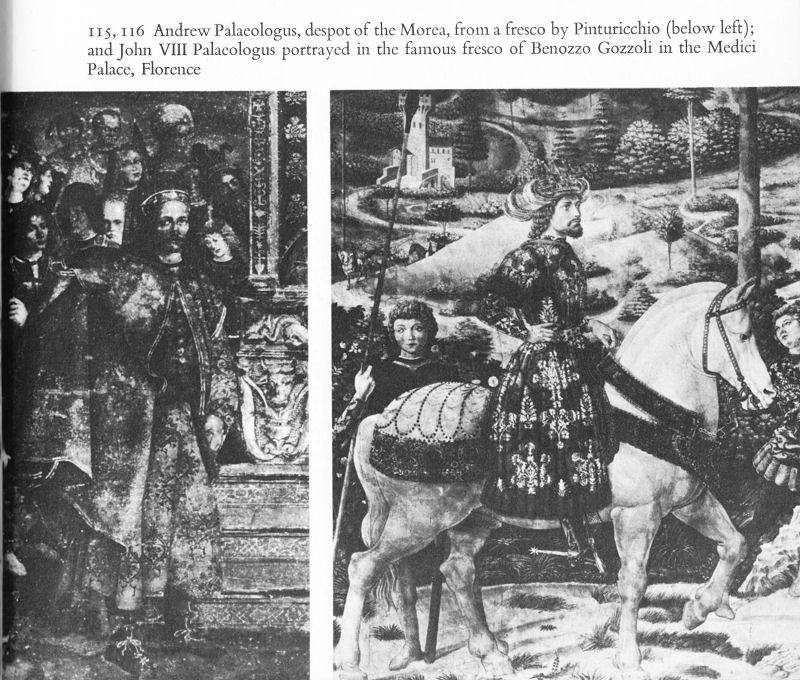
115, 116 Andrew Palaeologus, despot of the Morea, from a fresco by Pinturicchio (below left); and John VIII Palaeologus portrayed in the famous fresco of Benozzo Gozzoli in the Medici Palace, Florence
177
![]()
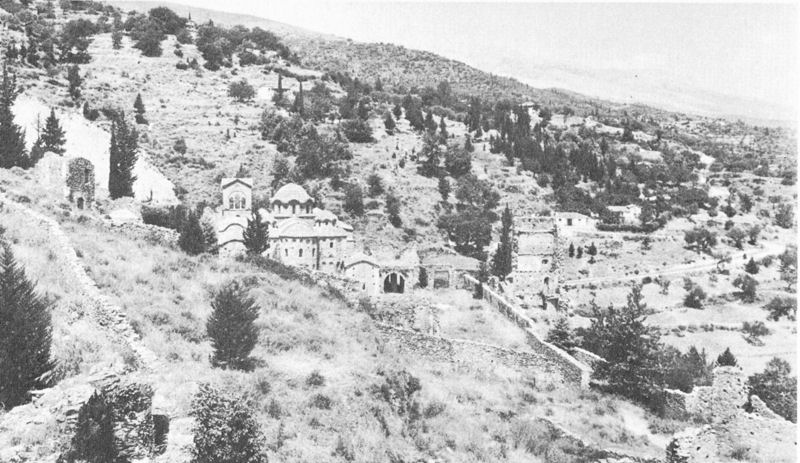
117 Mistra, a hill town in the Peloponnese, much as it was in the fourteenth century
7. THE LITERATURE OF DECLINE
In spite of the civil wars and military disasters which destroyed the empire, both art and literature flourished in the Palaeologan period. Though the obscurantist monastic outlook which was hostile to the classics persisted, the interest of Byzantine intellectuals now turned from the form of classical literature to its content. The Byzantine humanists studied Plato and Homer not only for the richness of their language but also because they found the subject-matter interesting and edifying; in short, they were intellectually sympathetic to the qualities and virtues which the ancient authors described. The university in Constantinople was once more reconstituted, and when Manuel II Palaeologus returned from his journey to the west he reformed it in the light of what he had seen at the Sorbonne.
Thessalonica, already distinguished as a centre of classical studies in the twelfth century, and Mistra were also important for their schools and intellectual activity. Mistra, the Byzantine capital of the Morea, became the focal point of a Greek national and intellectual revival under the political leadership of the Palaeologan princes and sustained by the literary activity of George Gemisthus Pletho.
178
![]()
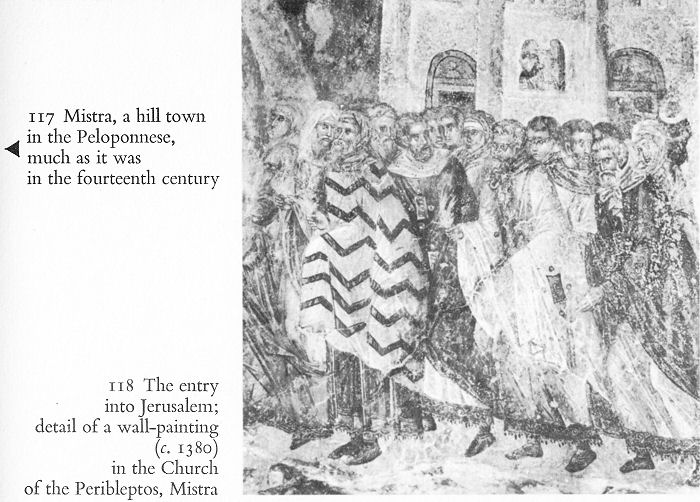
118 The entry into Jerusalem; detail of a wall-painting (c. 1380) in the Church of the Peribleptos, Mistra
It is interesting that Greek consciousness and cultural life were once more centred in their original homeland after having moved eastward during the Hellenistic-Roman and Byzantine eras. The conquests of Alexander and the rule of the Caesars had made Alexandria and Antioch the centres of Hellenism; later Constantine had made Constantinople the centre of the Greek-speaking world. After the Arab invasions Anatolia had become the heartland of Orthodox society, but the Turks, having reinvigorated the military power of Islam, erased the Greek character of Asia Minor, with the result that Greece once more became the centre of the Greek world.
The most spectacular aspect of Palaeologan intellectual life was the contact and exchanges between the Greek and Italian humanists of the fourteenth and fifteenth centuries. Though relations between Italy and Byzantium had become much closer since the eleventh century, these had been largely political and economic. Thanks to the rise of humanistic scholarship in the west and in the east, however, scholars of both worlds began to be interested in each other’s literature. Greek scholars began to translate Latin works into their own language and it is significant that they chose profane as well as religious compositions.
179
![]()
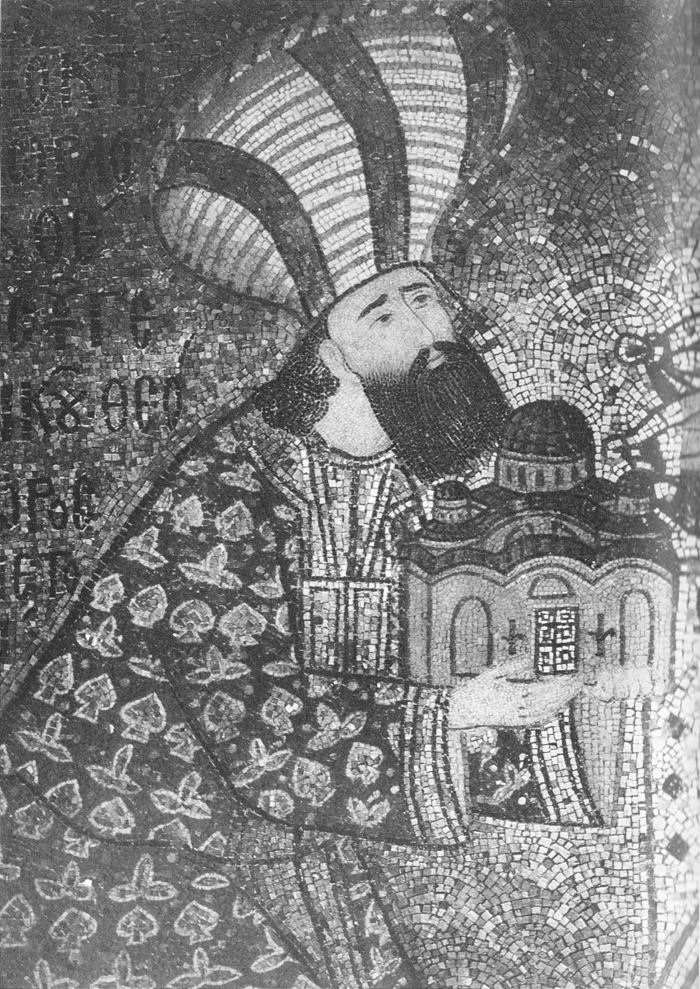
119 Theodore Metochites, humanist writer and bureaucrat, shown holding the Church of Kariye Jami, which was decorated under his patronage
190
![]()
The fourteenth-century scholar and ambassador to Venice, Maximus Planudes, translated works by Cato, Ovid, Cicero and Caesar, and Demetrius Cydones rendered into Greek such important theological treatises as the Summa Theologica of Thomas Aquinas and the anti-Islamic polemical tract of Ricoldo da Monte Croce. This latter became the principal source for Byzantine knowledge of Islamic doctrine.
But the Italy of Petrarch and Boccaccio thirsted more for Greek literature than did the Greeks for Latin. When the Greek humanist Manuel Chrysolorus accepted an invitation to lecture in Florence on Greek language and literature he was enthusiastically received, and after his return to Constantinople in the early fifteenth century Italian students soon followed him there. The interest of the Italians in learning Greek was motivated not only by pure humanism, for there was also the burning issue of religious union as well as economic and political involvement in the east. Religious and scholarly motivations momentarily fused, however, when the Byzantine emperor, accompanied by Greek scholars and clergy, came to Florence to effect the ecclesiastical union of 1439. The Italian humanists were enthralled by the arrival of such learned classicists as Bessarion and Pletho, and their presence in Italy gave a considerable impetus to the progress of Greek studies.
Greek literati of this late period became increasingly conscious of the empire’s decline and reflected this in their writing. One of the most brilliant of the humanists, the bureaucrat Theodore Metochites (d. 1332), had experienced the civil strife of Andronicus II and Andronicus III and had followed closely the Ottoman conquest of Bithynia. He clearly perceived the ever-widening disparity between imperial ceremony and pretensions in Constantinople and the grim reality of the empire’s position. The only cure for the melancholy which this perception inspired, he wrote, would be to remain ignorant of the empire’s past greatness. But since the historical monuments of past greatness could not be ignored, Metochites sought consolation in ruminating on the rôle of Chance (Tyche).
The lives of men and nations, he said, are governed by uncertainty and oscillations.
181
![]()
Nations which formerly ruled over others were then enslaved in their turn. This was the case with the Assyrians who became subject to the Persians, just as the Persians and all their subjects become subject to the Macedonians, and the Macedonians to the Romans. And these events occur in an alternating fashion according to chance of time and Tyche. Nor is there anything constant in human affairs nor unchangingly eternal. Just as every individual man or animal suffers birth, growth, decay and destruction and death, thus is it also in human affairs, governments, and dynasties. They also are in constant flux and change, and never constant. They come into being, progress, and then, gradually decaying and changing into the opposite state, they come to an end and die.
It was this reversal of fortune common to all states which, according to Metochites, had overtaken Byzantium.
These sad conditions inspired literary satire in the vernacular tongue, which ridiculed far more crudely than Metochites the unrealistic tone of much of Byzantine traditionalism. By the fifteenth century the empire had become so insignificant that historians such as Chalcocondyles and Critoboulos took as the subject of their narratives not Byzantium but the Ottoman Turks. Other men of letters, not resigned to the approaching end, recommended positive programmes of action. The Latinophile Bessarion proposed what historians today would call ‘westernization', for he recommended that Greek youths be sent to the west to study western technology. Pletho conjured up a new Greek state, along Platonic lines, which should be founded in the Peloponnese and which should return to paganism. But despite these ‘secular’ explanations and proposals Byzantine society retained its religious outlook to the very end and sought an essentially religious explanation for the catastrophic turn of events. Preachers told their congregations that God had sent the Turks to serve as divine chastisement of the sinful Christians. The most famous and sulphuric of these Byzantine preachers was Joseph Bryennius, the violence of whose sermons matched the very violence of the Turkish conquest.
182
![]()
Our rulers are unjust, those who oversee our affairs are rapacious, the judges accept gifts, the mediators are liars, the city dwellers are deceivers, the rustics are unintelligible, and all are useless. Our virgins are more shameless than prostitutes, the widows more curious than they ought to be, the married women disdain and keep not faith, the young men are licentious and the aged drunkards. The nuns have insulted their calling, the priests have forgotten God, the monks have strayed from the straight road. . . . Many of us live in gluttony, drunkenness, fornication, adultery, foulness, licentiousness, hatred, jealousy, envy, and theft. We have become arrogant, braggarts, avaricious, selfish, ungrateful, disobedient, deserters, robbers, traitors, unholy, unjust, unrepentant, irreconcilable. ... It is these things and other things like them which bring upon us the chastisements of God.
Whatever the causes of decline, be they the instability of human affairs, the virtues of the Turks, or the sins of the Greeks, it is remarkable that even at this late date the outlook of society was not fatalistic. For implicit in the explanation of Byzantine decline was the possibility of reversing the unfortunate state of Christian society. Tyche was not constant, sins could be abandoned and the virtuous life resumed, and Greek folklore expressed the common belief that eventually the Turks would be removed.
Though literary activity in a period of stress can be explained by the stimulating effect of political and military crises, these same conditions often exercise a deleterious effect on artistic output and development. For in periods of disaster survival becomes the primary concern of society and the energies, time, and money which art demands are not available. It is therefore extraordinary that Palaeologan art stands out as one of the really great achievements of Byzantine society. The high quality of this art is spectacularly revealed in the Church of the Chora (Kariyejami) which, under the patronage of Theodore Metochites, was embellished with brilliant mosaics and exquisite frescoes, though it is to be seen also in the monuments of Thessalonica, Mistra, and Serbia.
183
![]()
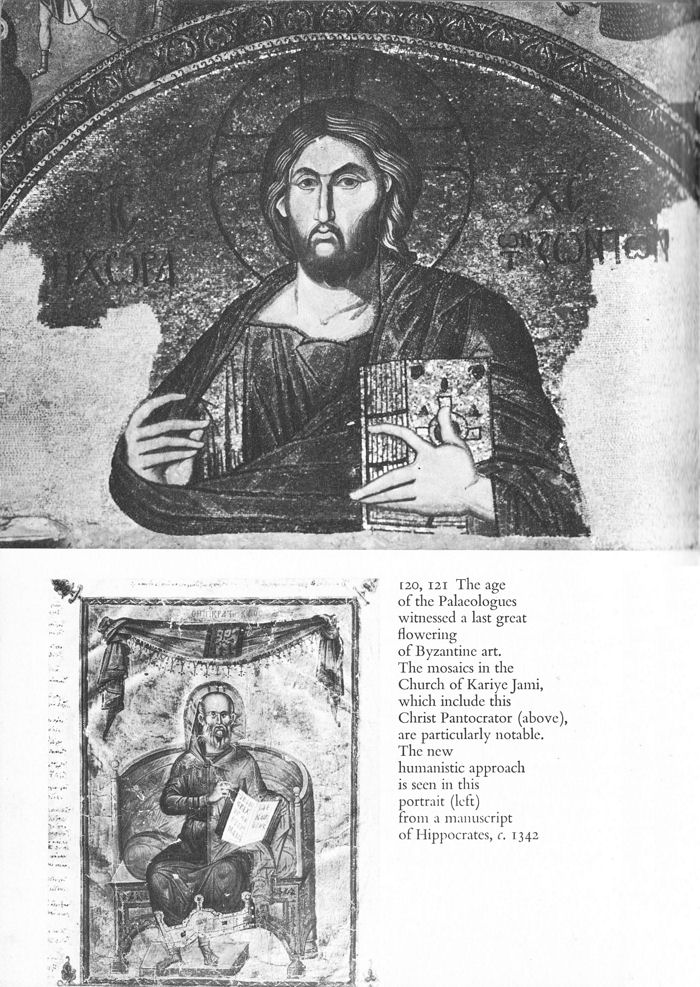
120, 121 The age of the Palaeologues witnessed a last great flowering of Byzantine art. The mosaics in the Church of Kariye Jami, which include this Christ Pantocrator (above), are particularly notable. The new humanistic approach is seen in this portrait (left) from a manuscript of Hippocrates, c. 1342
184
![]()
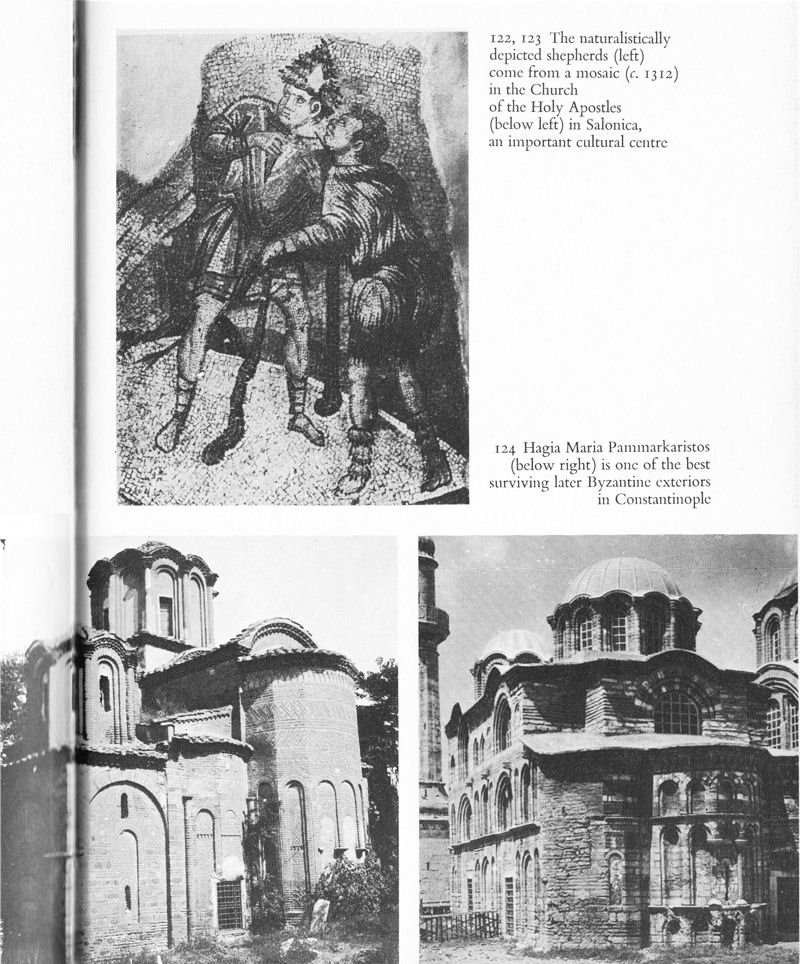
122, 123 The naturalistically depicted shepherds (left) come from a mosaic (c. 1312) in the Church of the Holy Apostles (below left) in Salonica, an important cultural centre
124 Hagia Maria Pammarkaristos (below right) is one of the best surviving later Byzantine exteriors in Constantinople
185
![]()
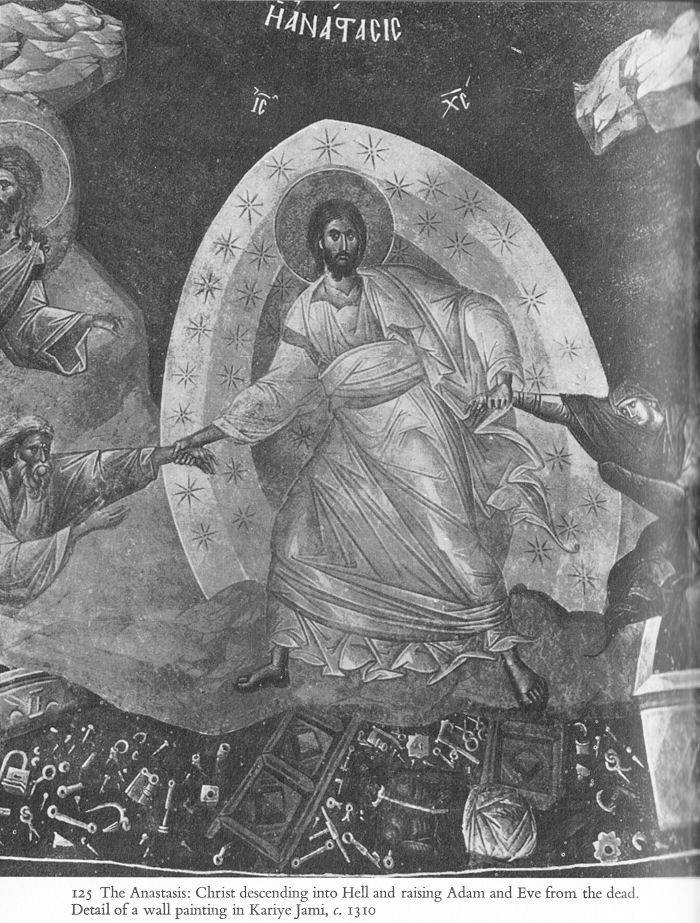
125 The Anastasis: Christ descending into Hell and raising Adam and Eve from the dead. Detail of a wall painting in Kariye Jami, c. 1310
186
![]()
8. THE END OF BYZANTIUM
The approaching end of the drama could be delayed no longer. Thanks to the rule of the energetic Murad II (1421-51) the Ottoman empire was once more firmly established in both the Balkans and Anatolia, and it only remained for Muhammed II to provide the new empire with its logical capital, Constantinople. In spite of its complete isolation, Constantinople still presented formidable obstacles to Muhammed who realized that the city could not be easily reduced. Therefore he built the fortress of Rumeli Hisar at the narrow point on the Bosphorus so that he might block the grain ships sailing to Constantinople. Muhammed was also concerned as to how he might breach the great land walls which barred his entrance into the city. It was the great misfortune of the Byzantine emperor to lose the services of his Transylvanian cannon-maker Urbanus, who deserted to Muhammed and built some extraordinary pieces both for Rumeli Hisar and for the coming siege of Constantinople.
Constantine XI did what little he could with the meagre resources at hand. He appealed to Pope Nicholas V for aid and the result was the last tem porary ecclesiastical union of the two Churches in 1452. The megadux Lucas Notaras and the anti-unionists denounced the act and declared that they would prefer to see the Turkish turban rather than the Latin tiara in Constantinople, but many of the people of Constantinople dissented stating that they would rather see the city in the hands of the Latins, who at least professed a belief in Christ. Thus the union divided the Greeks at this critical hour while failing to bring them the necessary aid from the west.
Muhammed deployed his troops before the land walls of Constaninople on Friday, 6 April 1453, and so commenced the last siege of Constantinople by barbarian armies. The struggle was unequal because the Ottoman forces, which conservative estimates place at 80,000, far outnumbered both the total number of the emperor’s forces (a mere 9,000) and the population of Constantinople itself (probably less than 50,000). The first bombardment of the city began on 11 April and the naval attack of the Ottoman fleet on 19 April was thwarted by the megadux Notaras at the iron chains blocking the entrance to the Golden Horn.
187
![]()
The failure of the Ottomans to force the chains and bring their fleet into the Golden Horn was serious, for it meant that the Greeks and Genoese could concentrate their scanty manpower on the land walls where the bulk of the Ottoman army was situated. But on the night of 22 April the Ottomans hauled their ships from the Bosphorus over the hill of Galata and to the accompaniment of rolling drums and screeching trumpets slid them into the waters of the Golden Horn.
Now the sea walls were exposed to Muslim attack and the emperor had to divert soldiers from the land walls to man the extensive walls along the northern shore of Constantinople. Even though this was a great Turkish success, the siege dragged on through the month of May and Muhammed offered Constantine terms by which the emperor could abandon Constantinople for the Morea. Constantine chose the path of honour and informed the Sultan that he preferred to die defending the capital.
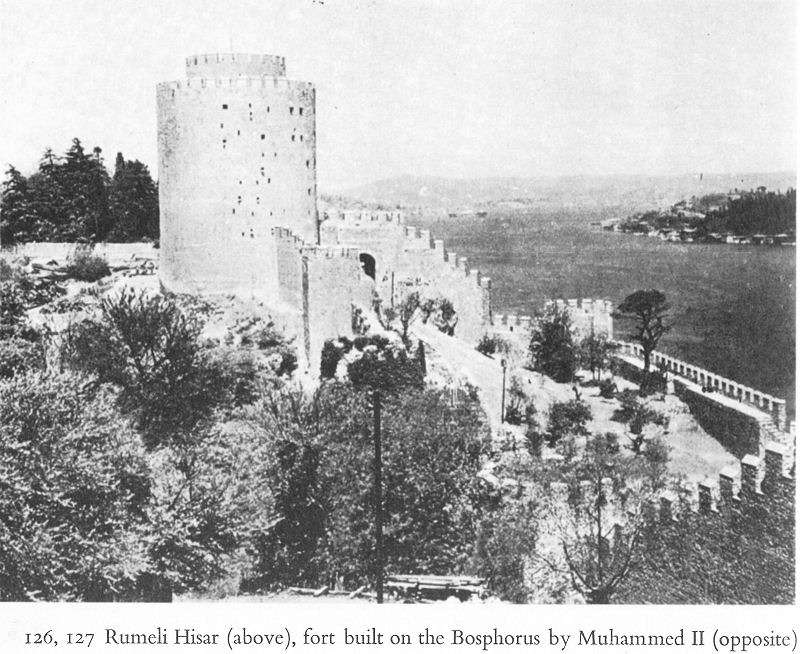
126, 127 Rumeii Hisar (above), fort built on the Bosphorus by Muhammed II (opposite)
188
![]()
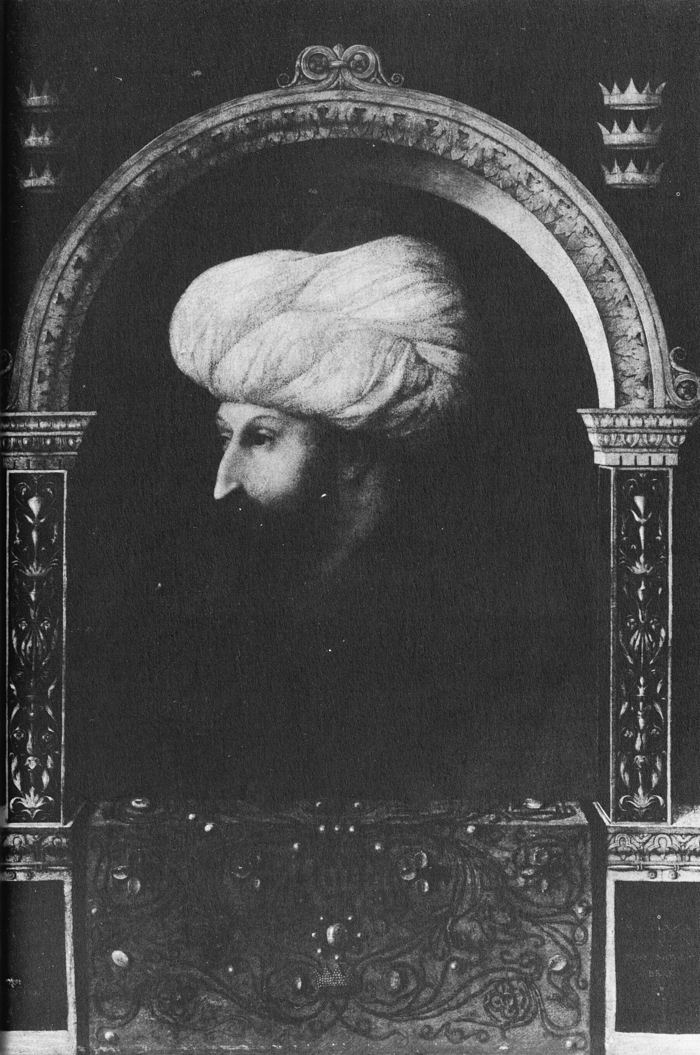
189
![]()
Muhammed therefore prepared a final assault and on 27 May inspected his troops, personally assigning each body its position. On the morning of the next day the Byzantines worked feverishly to repair breaches in the walls, litanical processions filled the streets, and miraculous icons were placed on the walls. The emperor, surrounded by Greeks and Latins, proceeded to Hagia Sophia where they heard the last Christian mass of the Byzantine empire and then returned to their positions on the walls.
The first Turkish assault, which began on the evening of 28 May, was repulsed but was followed by a second and more determined attack by the Anatolian soldiery. After they had been repelled, Muhammed ordered a third and final attack by the crack Janissaries on the morning of 29 May. During this attack the Genoese general, Giustiniani Longo, was mortally wounded and suddenly the Sultan’s standards were seen to float at one point inside the walls. The emperor and his troops continued to resist at the St Romanus gate where Constantine was slain by the Turks.
The Turks had finally breached the citadel of eastern Christianity and now the scenes of 1204 were repeated. Men, women, and children were massacred without discrimination or pity. After the first orgy of slaughter the victorious Muslims systematically plundered churches, monasteries, palaces and houses. Great numbers of prisoners were taken and enslaved, and the booty which the Ottoman soldiery gathered was such as they had never seen before. The historian Ducas describes the plunder of the city in detail:
Three days after the fall of the city he [Muhammed] released the ships so that each might sail off to its own province and city, each carrying such a load that it seemed each would sink. And what sort of a cargo ? Luxurious cloths and textiles, objects and vessels of gold, silver, bronze, and brass, books beyond all counting and number, prisoners including priests and lay persons, nuns and monks. All the ships were full of cargoes, and the tents of the army camps were full of captives and of the above enumerated items and goods. And there was to be seen among the barbarian host one wearing the sakkon of an
190
![]()
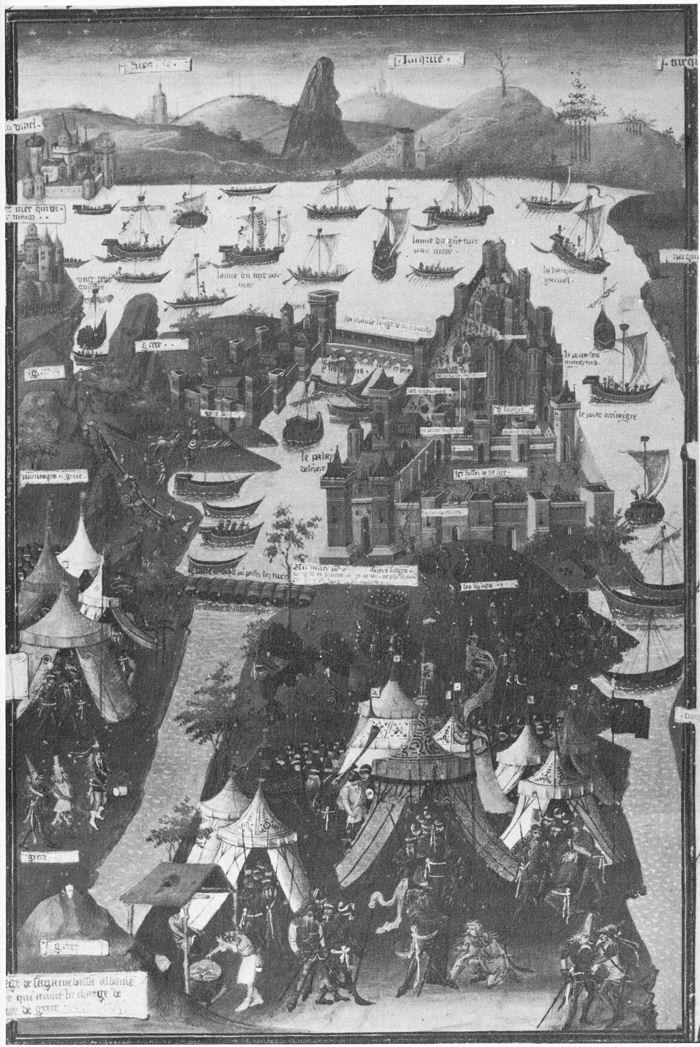
128 The capture of Constantinople by the Turks
191
![]()
archbishop, another wearing the gold epitrahelion of a priest, leading their dogs clothed instead of with the usual collars with gold brocaded amnous (ecclesiastical vestments). Others were to be seen seated at banquets, with the holy discs before them containing fruit and other foods, which they were eating, and with the holy chalices from which they drank their wine. And having loaded all the books, reaching unto a number beyond numbering, upon carts, they scattered them throughout the east and west. For one nomisma ten books could be bought (and what kind of books), Aristotelian, Platonic, theological, and every other kind. There were gospels which had every type of embellishment, beyond number, they smashed the gold and silver from them and some they sold, others they threw away. And all the icons were thrown into the flame, from which flame they broiled their meat.
After three days of horrible pillaging Muhammed entered Hagia Sophia, mounted the pulpit accompanied by an imam, and the Friday prayer was recited. The Sultan then entered the Christian sanctuary where he personally destroyed the altar, an act which symbolized the end of a thousand years of history.